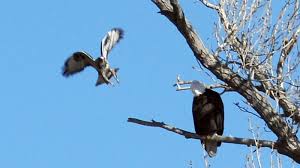The Badger and Eagle: A Unique Symbiotic Relationship
In the wild tapestry of nature, symbiosis—the interaction between different species for mutual benefit—takes many forms. Some relationships are as old as time, while others remain hidden in the shadowed corners of ecosystems. One of the lesser-known, yet fascinating, partnerships occurs between two very different animals: the badger and the eagle. Though it may seem improbable that such disparate creatures could form any sort of relationship, their unique symbiotic bond reveals the intricate and unexpected ways in which life intertwines.

The Players: Badger and Eagle
At first glance, a badger and an eagle seem to have little in common. Badgers, burrowing creatures with short, stocky bodies, are ground dwellers. They are nocturnal, spending their days tucked away in elaborate underground homes. Their digging habits leave them vulnerable to predators, but they are formidable in their own right, with powerful claws and a reputation for aggressive defense.
Eagles, on the other hand, are majestic birds of prey, known for their keen vision and formidable hunting abilities. They dominate the skies, soaring with unmatched grace and power. They are predators by nature, often hunting smaller mammals and fish, and they nest in tall trees or high cliffs, far removed from the underground world of badgers.
Yet, against this backdrop of apparent incompatibility, a surprisingly close relationship emerges, particularly in certain regions of North America and parts of Europe.
A Mutualistic Connection
The core of the badger-eagle relationship lies in the concept of mutual benefit. Badgers and eagles form a loose yet beneficial connection, particularly during certain seasonal conditions. The relationship hinges on the fact that these two species have complementary roles within the food chain.
- Badgers as Scavengers for Eagles
One of the most crucial ways in which the badger benefits the eagle is through its foraging habits. Badgers, while digging their dens and searching for food, often uncover prey that may be too small for them to consume entirely. This includes small rodents, birds, and even the eggs of ground-nesting birds. When badgers leave these carcasses or remnants behind, eagles are quick to swoop in, scavenging the leftovers. While eagles are excellent hunters, they are not above scavenging when the opportunity arises, and the badger’s digging provides an easy source of meals. - Eagles as Sentinel Guardians for Badgers
Eagles, due to their sharp vision and high perch, are able to spot potential threats from miles away. This serves as a protective advantage for the badger, whose burrows and underground homes can be vulnerable to larger predators, such as wolves or coyotes. The eagle’s keen eyesight helps warn the badger of approaching danger. When an eagle spots a predator from above, its piercing call or flight patterns may act as a signal for the badger to retreat into its den or seek shelter. - Enhanced Hunting Grounds
The presence of badgers can also help eagles by creating hunting opportunities. As badgers dig in search of food, they often disturb the earth and unearth small animals that would otherwise remain hidden underground. This disturbance, while beneficial for the badger, also exposes small mammals to the keen eyes of eagles. In this way, both animals benefit from the activities of the other—badgers uncovering food for themselves and eagles taking advantage of the upheaval in the ecosystem.
A Silent, Unspoken Bond
What makes the badger-eagle relationship so unique is the apparent lack of direct interaction between the two animals. Unlike the more famous partnerships between species, like the oxpecker and the buffalo, or the cleaner fish and larger marine creatures, the badger and eagle do not actively seek each other out or directly engage in their symbiosis. Instead, their bond is subtle, built on the shared use of space and resources in an environment that encourages opportunism.
In this quiet partnership, there is no need for a constant exchange of services or mutual grooming. The badger and eagle simply coexist in ways that enrich each other’s lives, though the full extent of their relationship may go unnoticed by casual observers. The benefit is less about direct cooperation and more about how each species’ unique strengths and habits provide advantages to the other, even without an explicit exchange.
Nature’s Design: A Lesson in Balance
The badger-eagle relationship serves as a reminder of nature’s delicate balance, where each creature, no matter how seemingly unimportant, has a role to play. In this case, the ground-dwelling badger and the soaring eagle demonstrate that even vastly different animals can work in tandem, not through direct collaboration, but through the simple act of inhabiting the same environment. The badger benefits from the eagle’s vigilance and the bounty of the land it uncovers, while the eagle thrives off the food sources that the badger inadvertently provides.
In the grander context of ecological systems, these kinds of subtle relationships are not uncommon. Nature, after all, thrives on complexity, and the more we learn about the ways in which species interrelate, the more we come to understand that even the most unlikely alliances contribute to the intricate web of life that sustains our planet.
Conclusion
Though it may seem improbable at first, the relationship between the badger and the eagle is a testament to the fascinating ways in which nature works. By playing to their individual strengths, these two animals forge a connection that enhances their survival, revealing a remarkable example of mutual benefit. In a world often dominated by direct, obvious symbiotic interactions, the badger and eagle remind us that sometimes, the most powerful bonds are the quiet, invisible ones—woven into the very fabric of the ecosystem they inhabit.
